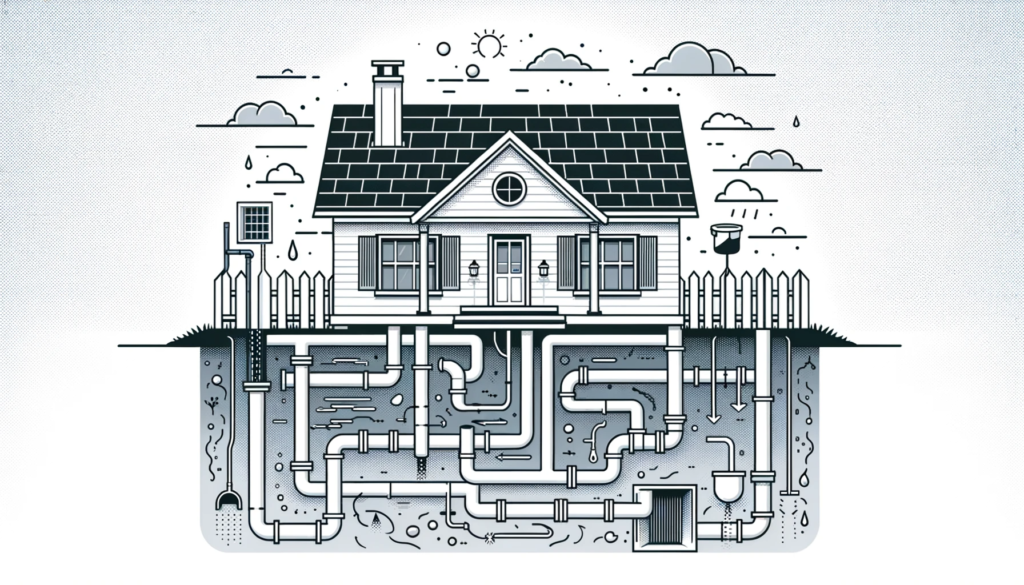Understanding Your Home Drainage System

When we talk about home comfort, one aspect that often gets overlooked is the home’s drainage system. Yet, it’s one of the most crucial components of modern living—nobody wants the unpleasant surprises that come from plumbing mishaps. Getting to grips with the intricacies of your residential drainage system isn’t just about preventive measures, it’s about saving yourself from the eventual headache and cost of emergency repairs.
It’s worthwhile taking the time to understand the different parts of your home’s drainage system and how they work together. Your system typically includes main drains, vent stacks, clean-outs, and traps. Each component has a specific job, from allowing water to exit your home to preventing sewer gases from coming in. With a bit of knowledge, you can more easily identify issues like a slow draining sink or a toilet overflow, and figure out the appropriate course of action. You can learn more about the nuances of residential drains by visiting the Understanding Residential Drains page.
| Component | Function |
|---|---|
| Main Drains | Carry wastewater away from the home |
| Vent Stacks | Allow air into the plumbing system to maintain proper drainage |
| Clean-Outs | Provide access to the plumbing for cleaning blockages |
| Traps | Prevent sewer gases from entering the home through drains |
Remember, regular inspection and maintenance are key to catching issues early. It’s not always the most glamorous of homeowner duties, but it can prevent the most common problems from escalating. Keep your eyes and nose alert for signs of trouble, and you’ll be well on the way to safeguarding your home.
Types of Drain Problems
The variety of drain problems that can plague a household are many and, unfortunately, quite common. Some of you might be all too familiar with the frustration of dealing with clogged drains—that persistent issue that seems to occur at the most inconvenient moments. There are multiple drain issues that can disrupt your daily life, and being aware of them is the first step to prevention and solution.
Let’s delve into a list of the most common residential drain problems:
- Blockages: Hair, grease, and foreign objects can create stubborn clogs in sinks, showers, and toilets.
- Root Intrusions: Tree roots can find their way into sewer lines, causing backups and blockages.
- Pipe Corrosion: Over time, pipes can deteriorate, leading to leaks or restricted water flow.
- Toilet Overflows: A nightmare scenario that can be caused by blockages or malfunctioning components.
- Sewer Backups: Potentially the most distressing, caused by blockages or issues with the main sewer line.
For each of these issues, there are DIY drain solutions for the handyperson in all of us. But sometimes, it is better to call in professionals who have the right tools and expertise—especially for major concerns like sewer backups or pipe corrosion. It’s never a bad idea to familiarize yourself with basic troubleshooting steps, which you can find on the Common Drain Problems guide.
DIY vs. Professional Help
Taking on a do-it-yourself project can be immensely satisfying, and indeed, some drain problems fall well within the realm of a savvy homeowner’s abilities. Clearing minor clogs or performing basic routine maintenance are DIY tasks that many of you can handle on your own, provided you have the right tools and a bit of know-how.
However, there’s a fine line between what’s manageable and what’s better left to professionals. For instance, if you’re experiencing recurring blockages, water backing up in multiple fixtures, or suspect sewer line issues, it’s time to call in the experts. Professional drain cleaning services possess the specialized equipment and experience necessary to diagnose and correct the more complex issues that can plague your drainage system. To get an idea of what you can attempt yourself, check out the DIY Drain Installation article for guidance.
| DIY Tasks | Professional Tasks |
|---|---|
| Clearing minor clogs | Sewer line repairs |
| Basic maintenance | Addressing recurring blockages |
| Replacing components like p-traps | Full system diagnostics and inspection |
| Installing simple fixtures | Hydro-jetting and other advanced cleaning techniques |
Safety first: Always remember to safeguard your health and home when attempting DIY tasks. Many drain cleaning chemicals can be harsh and potentially damaging, so use them carefully or opt for environmentally-friendly alternatives whenever possible.
Preventative Measures for Your Drains
An ounce of prevention is worth a pound of cure—a timeless adage that definitely applies to residential drainage care. You can avoid the common drain problems by adopting a proactive approach to maintenance. Here are several preventative measures that can help keep your drains running smoothly:
- Regular Cleaning: Weekly cleaning of sink stoppers and strainers can prevent hair and debris build-up.
- Mind What You Flush: Only human waste and toilet paper should go down toilets, to prevent clogs and backups.
- Proper Disposal of Grease: Never pour cooking grease down the drain; it solidifies and causes blockages.
- Use Drain Screens: Install these in showers and sinks to catch hair and particles before they cause problems.
If you institutionalize these habits, you’ll likely see a significant reduction in emergency calls to plumbers. For more detailed advice on keeping your drainage system in top condition, head over to the helpful tips on Drain Maintenance Tips.
| Preventive Action | Benefit |
|---|---|
| Weekly cleaning of drains | Reduces build-up and blockages |
| Cautious flushing | Prevents clogs and overflows |
| Proper disposal of grease | Avoids pipe blockages |
| Use of drain screens | Catches debris and hair |
Incorporate these measures into your routine, and you’ll not only extend the life of your plumbing but also ensure that your home is a more comfortable and functional space.
Eco-Friendly Practices for Drain Management
In today’s world, being eco-conscious is no longer just an option—it’s a necessity. The good news is that there are plenty of strategies for maintaining your home’s drainage system that are kind to the environment. For example, biodegradable cleaners, which use enzymes to break down organic material, are a fantastic alternative to harsh chemicals. These cleaners are not only safer for the pipes but also for the wider environment as they do not contain pollutants.
Investing in water-efficient fixtures is another eco-friendly initiative. Low-flow toilets and showerheads conserve water and reduce the strain on wastewater systems. Collectively, these small changes make a significant impact on the environmental footprint of your household. To embrace more sustainable practices, be sure to check out our guide on Eco-Friendly Drain Solutions.
| Eco-Friendly Product | Environmental Benefit |
|---|---|
| Biodegradable Cleaners | Safe for ecosystems; break down easily |
| Water-Efficient Fixtures | Conserve water; lower utility bills |
| Rainwater Harvest Systems | Reduce demand on municipal water supply |
Remember, looking after the planet is a shared responsibility, and the way you manage your drains can play a role in the bigger picture of ecological stewardship.
Emergency Drain Issues: What to Do
Plumbing emergencies can strike at any time, leaving you to deal with overflowing toilets, backed-up sewer systems, or burst pipes. When you encounter these critical issues, it’s essential to act swiftly to minimize damage and resolve the problems as quickly as possible. First and foremost, know the location of your main water shutoff valve—this is your first line of defense in a water-related emergency to stop the flow and prevent further flooding.
For severe blockages or backups, don’t hesitate to call for professional assistance. The sooner you can get an expert on the scene, the better your chances of a swift and effective resolution. In the meantime, you can utilize a plunger or a plumbing snake for minor clogs, but avoid using chemical cleaners as they may exacerbate the situation or inflict damage to your pipes. For more advice on what to do in an emergency, look no further than the Emergency Drainage Solutions section of Drain Fix Pros.
| Emergency Situation | Immediate Action |
|---|---|
| Overflowing Toilet | Shut off the water; use a plunger |
| Burst Pipe | Turn off the main water supply |
| Sewer Backup | Call a professional immediately |
Taking these prompt actions can go a long way toward protecting your property and ensuring the safety of everyone in the household.
Impact of Drainage on Home Value
Good drainage is a significant factor in maintaining the integrity and value of your property. Issues like standing water, soggy yards, and basement dampness are not only nuisances but can also lead to severe structural damage over time. When it comes to selling your home, potential buyers will certainly take note of any signs of poor drainage, which can affect their offer price or decision to buy.
Smart landscaping that directs water away from the house and installing proper gutters and downspouts are just some of the ways to enhance drainage on your property. Moreover, addressing any current drainage issues can be a wise investment that pays off in the long run by protecting the foundation of your home and its overall value. For deeper insights on how proper drainage can benefit your property’s worth, refer to the article on Drainage and Home Value.
| Factor | Impact on Home Value |
|---|---|
| Effective drainage | Enhances structural integrity |
| Landscaping | Elevated aesthetic and function |
| Foundation protection | Increases buyer confidence |
Prioritizing your home’s drainage not only ensures a comfortable living space but also secures a promising financial future.
Solutions for Older Homes with Outdated Drainage
Older homes are full of character and history, but they often come with outdated plumbing that doesn’t meet today’s standards or demands. If you live in such a home, it’s crucial to assess your drainage system and upgrade where necessary. Retrofitted pipes, installing additional clean-outs for easy access, or even relining existing sewer pipes can make a significant difference in the performance of your home’s drainage.
It is essential to hire professionals experienced with older homes as they require a delicate approach to preserve the home’s integrity while improving functionality. These experts can provide tailored solutions that respect the original architecture and structure of your home. For more targeted advice for your vintage abode, visit Drainage in Older Homes for a rundown on special considerations and potential upgrades.
| Landscaping Feature | Drainage Benefit |
|---|---|
| Sloped grading | Directs water away from structures |
| Absorbent vegetation | Reduces surface water levels |
| Permeable paths | Enhances ground water absorption |
Committing to these upgrades can ensure that your beautiful, old house remains sturdy and functional for many years to come.
Drainage and Home Landscaping
The landscaping of your yard is not just about aesthetic appeal—it also plays a crucial role in your home’s drainage system. Intelligent landscaping can prevent issues such as soil erosion and standing water, both of which can lead to significant problems for your property over time. Consider these landscaping tips for effective drainage:
- Grading: Make sure the ground slopes away from your home to direct water runoff properly.
- Plants: Utilize plants, shrubs, and trees that absorb excess water and help reduce runoff.
- Rain Gardens: Create rain gardens to catch runoff and allow it to percolate into the soil.
- Drainage Solutions: Incorporate French drains or dry creek beds into your landscape design for water management.
For each of these strategies, careful planning and execution are necessary. With the right approach, your landscaping can complement your drainage system, ultimately protecting your home’s foundation and structure. Dive into more details on integrating these elements effectively at Landscaping and Drainage.
| Landscaping Feature | Drainage Benefit |
|---|---|
| Sloped grading | Directs water away from structures |
| Absorbent vegetation | Reduces surface water levels |
| Permeable paths | Enhances ground water absorption |
By incorporating these features into your yard, you not only add to your property’s charm but also contribute to its resilience against water damage.
Conclusion
In wrapping up our discussion on common residential drain problems, it’s clear that knowledge and proactive measures are your best defense. Understanding the various aspects of your home’s drainage system not merely prevents unpleasant surprises but can also have a positive impact on your property’s worth. Whether through DIY maintenance or employing expert solutions for more complex issues, preserving the health of your drains is a crucial part of home ownership.
Feel free to revisit sections like Understanding Residential Drains and Preventing Drain Blockages to bolster your understanding and capability in managing your home’s drainage effectively. It may seem daunting at times, but with the right resources and occasional professional assistance, you can ensure that your drainage system remains a silent, reliable workhorse in your home.




